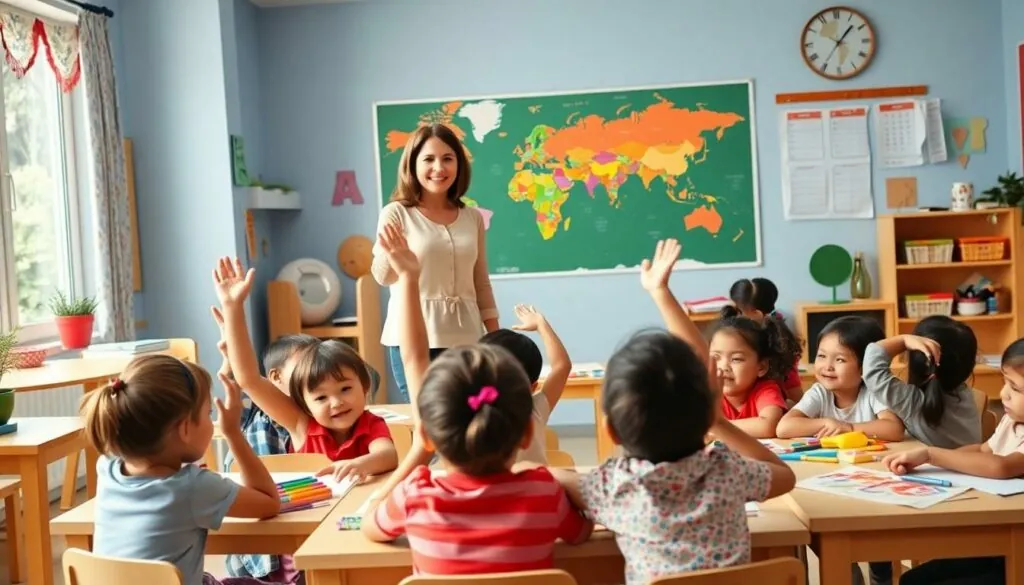Imagine a world where kids can chat effortlessly in two languages, impressing their friends and confusing their pets. Dual language learning isn’t just a fancy buzzword—it’s a powerful educational approach that equips students with the skills to navigate our increasingly globalized society. By immersing learners in two languages from an early age, this method cultivates bilingualism and biliteracy while fostering cultural awareness.
But let’s be real; it’s not just about being able to order tacos in Spanish or bragging about your French skills at a dinner party. Dual language learning opens doors to countless opportunities, enhancing cognitive abilities and academic performance. So, if you’re curious about how this dynamic approach can transform education and empower the next generation, buckle up! This journey into the world of dual language learning is about to get interesting.
Table of Contents
ToggleWhat Is Dual Language Learning?
Dual language learning involves an instructional approach that integrates students from diverse linguistic backgrounds. This method promotes fluency in two languages, typically a native language and a second language. It focuses on teaching academic content in both languages, allowing students to develop biliteracy.
Students benefit from dual language programs in numerous ways. Research shows that immersion in two languages enhances cognitive functions, aiding problem-solving skills and critical thinking. Exposure to different cultures fosters open-mindedness and empathy, preparing students to interact positively in a multicultural environment.
Programs vary in structure and implementation across educational settings. Some schools offer 50/50 models, where half of the instruction occurs in each language, while others may provide a 90/10 model, emphasizing the target language initially. Instruction primarily aims to create an inclusive learning atmosphere, where all students feel valued regardless of their language proficiency.
Challenge exists in maintaining a balanced approach between the two languages. Teachers must ensure that both languages receive adequate exposure to foster fluency. Monitoring progress is essential, as students must show proficiency in each language to thrive academically.
Collectively, dual language learning represents a significant shift in educational practices. It prepares students for future opportunities in a globalized world and enhances communication skills. Ultimately, this approach lays the foundation for lifetime learning and appreciation of diverse cultural identities.
Key Components of Dual Language Learning
Dual language learning consists of essential elements that shape the educational experience. Two key components are bilingualism and biliteracy, both crucial for effective language acquisition.
Bilingualism
Bilingualism refers to proficiency in two languages. In dual language programs, students engage in both their native language and a second language. This immersive approach fosters communication skills and cultural understanding. Moreover, research shows that bilingual individuals often exhibit enhanced cognitive abilities. For example, they may demonstrate superior problem-solving skills, as well as improved multitasking capabilities. Exposure to diverse languages cultivates empathy and openness to various cultural perspectives. Bilingualism not only enriches students’ personal lives but also prepares them for an interconnected world.
Biliteracy
Biliteracy encompasses the ability to read and write in two languages. In dual language settings, students learn academic content in both languages, establishing a strong foundation. This approach encourages critical thinking and deep comprehension skills. Programs often integrate literacy activities that promote writing and reading proficiency. For instance, students might participate in storytelling sessions or collaborative writing projects in both languages. Mastering biliteracy offers learners expanded academic opportunities and prospects for future employment. Establishing biliteracy lays the groundwork for lifelong learning and appreciation of diverse linguistic heritages.
Benefits of Dual Language Learning
Dual language learning offers multiple advantages that significantly enhance the educational experience. This approach supports cognitive development and fosters cultural awareness among students.
Cognitive Advantages
Cognitive benefits of dual language learning include improved memory, problem-solving abilities, and multitasking skills. Immersion in two languages enhances brain function, stimulating neural connections that support critical thinking. Research shows that bilingual individuals often perform better on tasks requiring concentration and analytical skills. Additionally, developing proficiency in two languages fosters greater adaptability and creativity, making students more adept at navigating complex challenges in academic settings. Engaging with diverse linguistic structures also refines their understanding of language mechanics, ultimately boosting overall academic performance.
Cultural Awareness
Cultural awareness emerges as a vital benefit of dual language learning. Exposure to multiple languages immerses students in diverse cultural perspectives and traditions. Engaging with different communities helps cultivate empathy and open-mindedness. Students learn to appreciate and respect cultural differences, which strengthens social cohesion in increasingly diverse environments. Understanding various worldviews enhances global citizenship, equipping students with the skills needed to collaborate in international contexts. By embracing cultural diversity through language, dual language learners develop a richer understanding of their own identities while fostering inclusivity in their communities.
Challenges in Dual Language Learning
Challenges exist within the dual language learning framework, impacting its effectiveness and sustainability. Teachers, students, and institutions must navigate various hurdles in this unique educational setting.
Implementation Issues
Implementation issues may arise from resource limitations, including qualified teachers and appropriate materials. Schools often struggle to recruit educators who are proficient in both languages. Classroom dynamics also present hurdles, as educators must balance instruction in two languages while catering to diverse student needs. Program consistency can suffer due to varying administrative support or changes in educational policy. Each of these factors can disrupt the delivery of dual language programs, complicating the overall learning experience for students.
Student Motivation
Student motivation plays a critical role in the success of dual language learning. Some learners may lack interest in mastering both languages, especially if peers do not share the same goals. Moreover, the pressure to perform in two languages can create anxiety, negatively impacting engagement. Students who do not see immediate relevance in their bilingual education might struggle with motivation. Therefore, fostering a sense of purpose and relevance in language acquisition is essential to maintain enthusiasm and commitment among learners.
Conclusion
Dual language learning stands as a powerful educational approach that equips students with essential skills for a multicultural world. By fostering bilingualism and biliteracy, it not only enhances cognitive abilities but also cultivates a deeper appreciation for diverse cultures. The transformative potential of this method is evident in its ability to prepare learners for future academic and professional opportunities.
While challenges exist in implementation and student engagement, the benefits of dual language learning far outweigh the obstacles. As educators continue to refine their strategies and create inclusive environments, the impact of dual language programs will likely resonate for generations to come. Embracing this approach is crucial for nurturing well-rounded global citizens.




